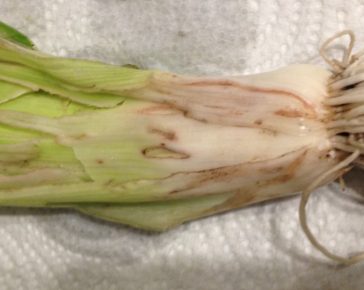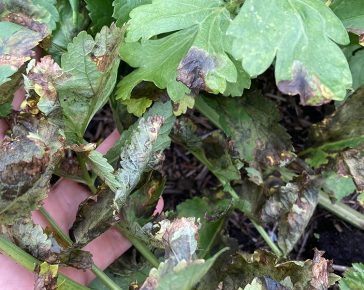I thought I’d write a bit about leaf miners this week, because they seem to be strangely active in my veg garden. I know that normally they would not be a problem at this time of year, but with the temperatures being fairly mild here in Cornwall, apart from a brief few days of cold frosty weather and perhaps a smattering of three snowflakes (which is practically a blizzard by Cornish standards) on one day, they’re still active.
What are leaf miners?
We’re talking here about the larvae of leaf miner flies – there are, apparently, around 300 species worldwide and they can cause damage to all sorts of different plants.
Which crops are affected in the veg garden?
Probably the most common crops affected are beetroot, chard and spinach which are often the victims of Beet Leaf Miner. A lot of salad leaves can be affected, too, as per the picture above which is a pot of landcress that I’ve been growing just outside the kitchen window. You can see the squiggly trails reasonably clearly in this photo, but there are also Allium Leaf Miners (article below) that target leeks and this looks slightly different – more like the leek leaves have been shredded – and celery leaf miners (article below) which again looks different and which target plants like celeriac and parsnips as well. In the summer months you can also find leaf miner damage to greenhouse plants, particularly tomatoes.
What damage do leaf miners do?
Generally speaking, the leaf miner larvae bury into the leaves and create tunnels underneath the film-like surface of the leaf. The leaf will begin to rot from the tunnels.
In best case scenario, the damage is cosmetic and you can simply pick off the affected leaves and enjoy the rest. However, with a more significant infestation, the damage to the leaves causes damage to the rest of the plant – tomato yields can be low, for example, and beetroot won’t grow so big.
How can I protect my crops from leaf miners?
The best thing I have found is simply to cover crops with mesh or fleece – I have to admit that I’m not very good at remembering to do this, and I tend to just wing it during the growing season and hope for the best leaving most of my veggies uncovered. I suppose I grow enough anyway that it doesn’t bother me too much if some of the spinach leaves are unusable, but perhaps if you’re growing on a smaller scale you might want to be a little more conscientious! The other thing you can try in a greenhouse is yellow sticky traps. It’s also good to encourage parasitic wasps into the garden as these help to keep leaf miner numbers down – growing dill and fennel can help to do that (although be aware that bronze fennel grows huge and self-seeds easily, so don’t do what I did and forget to cut it back after it has flowered!)




